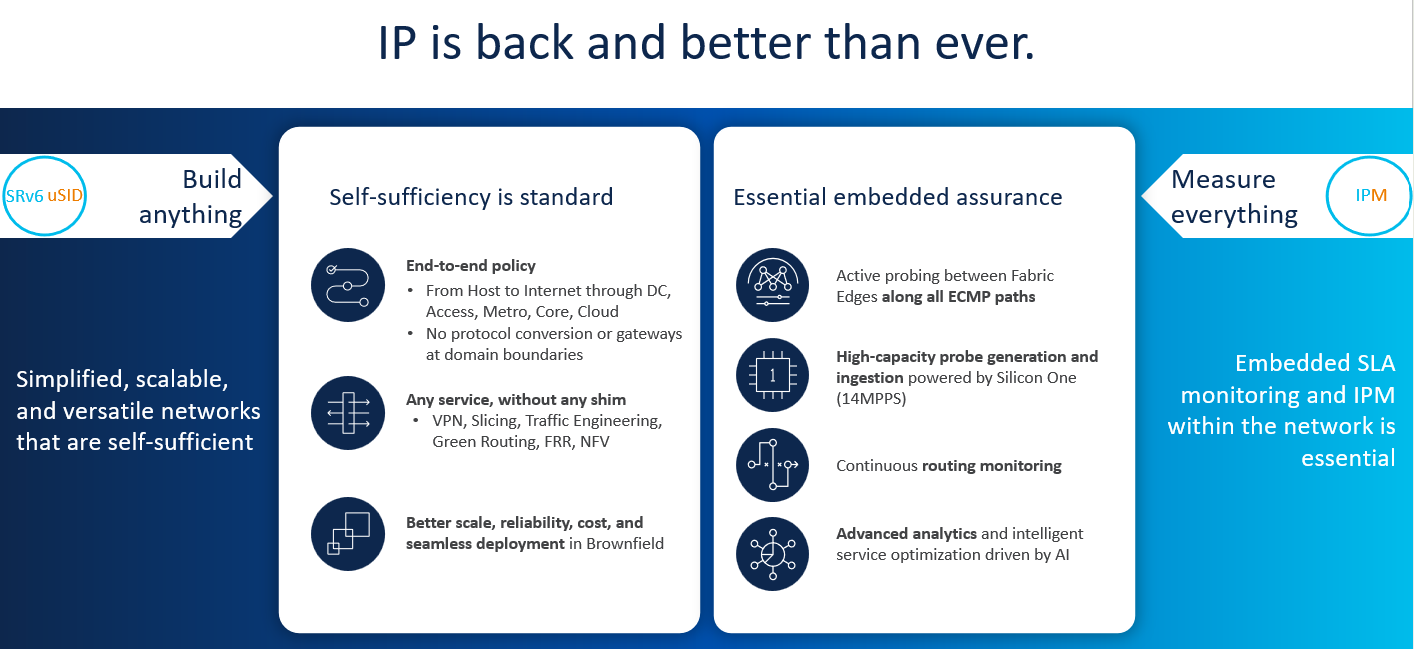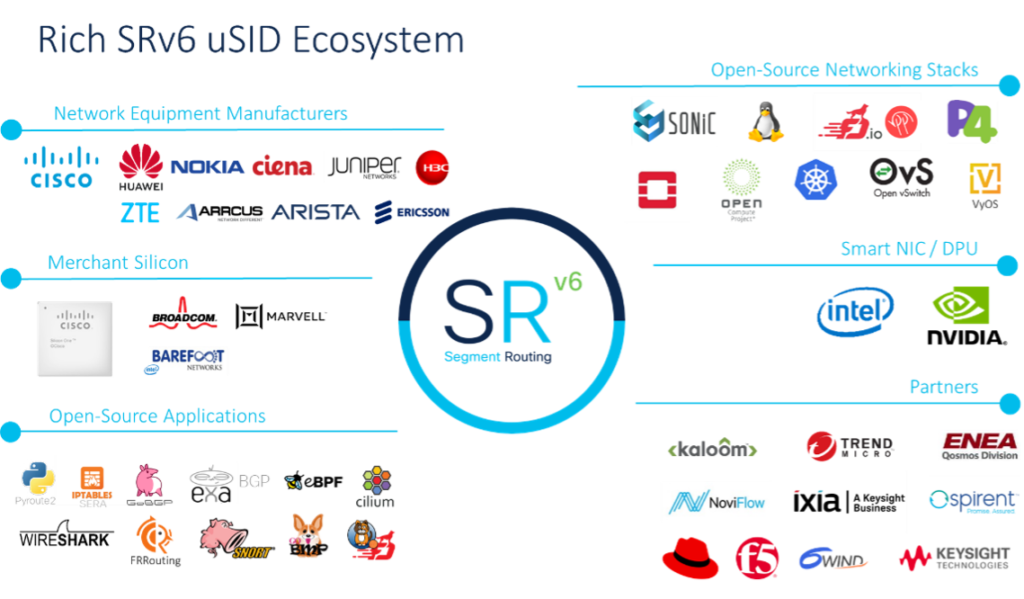Making IP networks self-sufficient
01/07/2024

Written by Pablo Camarillo, Making IPv6 networks self-sufficient
IP is at the heart of our lives. Every time we use the mobile phone, it’s on an IP network. Every time we send an email is through an IP network. When we stream a movie is over an IP network. When we control our smart home appliances it’s over an IP network.
Interestingly enough, we have accepted the fact that IP cannot deliver any form of service by itself, and it needs additional hacks to solve its limitations. For example, whenever there is a need to deliver Traffic Engineering, we need to rely on MPLS. Similarly, IP doesn’t provide any native VPN mechanism. This has been solved with VXLAN, GRE, or any of the plethora of VPN tunneling protocols. This is also the case with NSH for Service Chaining or GTP for mobile networks.
Today on each single domain you have a limitation and a shim-protocol to solve that specific limitation. But the picture gets even more complex: when we need to have a policy that goes through several domains, these shim layers are not compatible in between them, and we need to deploy gateways at domain boundaries to translate between protocols. This is often the case for policies starting at the DC (i.e., VxLAN) that need to traverse the metro (i.e., MPLS). We always need to deploy a gateway in between both domains to perform protocol translation.
Almost 10 years ago a group of passionate network engineers embarked on a journey to simplify networks by bringing back IP, in a self-sufficient manner, and removing all the unnecessary shim-layers that the industry has heavily relied on. This is what led to the inception of SRv6 uSID, with the intention to make IPv6 self-sufficient. It is based on three pillars:
- End-to-end: The ability to have a single policy across domains, all the way from the host up to the cloud through the access, core, and metro. This is tremendously beneficial, as it allows to remove the gateways that are placed at domain boundaries. Such gateways perform DPI and protocol conversion functionality, and hence are a bottleneck in terms of scale and reliability, aside from the huge cost they represent. In addition to the removal of this gateways, this end-to-end principle also aids bringing control of the policy closer to the application, the socket, that is the one who knows what is the intent that is required for the traffic.
- Any service, with no shim layers: you can build any form of traffic engineering, fast-reroute, VPNs, slicing, service chaining, or any other service natively without any shim layer. Any additional protocol only adds operational complexity and additional cost, and hence we seek simplification.
- Scalable, reliable, and seamless deployment: uSID has been built on top of the most fundamental building block, IP Longest Prefix Match. We hide the network program behind this 30-year-old principle of IP. This provides the seamless deployment behavior allowing to encode a uSID network program amongst legacy IPv6 nodes. In addition, it provides better routing scale. As reported by Bell Canada, SRv6 uSID provides at least 500 times better routing scale than MPLS thanks to IP Summarization, allowing to have more nodes on each domain.

But the solution is not limited to building anything. In addition, the solution must also deliver embedded assurance. It is not a secret that network assurance is of paramount importance, and we are shifting into a customer experience-oriented era, were networks need to be SLA-obsessed. That is why the solution also has a second pillar, that is IP Measurements. It delivers embedded assurance, right into the IP nodes, by generating the probe natively from the hardware. It ensures that all ECMP paths are measured, and the measurements are aggregated and reported using rich metrics unlike the industry defacto standard of min, max, avg which fall very short from a statistical point of view. IP Measurements will be covered in a subsequent blog.
Outperforming on a per-domain basis
In engineering, a common paradox is that solutions designed for multiple segments are often outperformed by custom solutions tailored to specific segments. For instance, if we look at vehicles, a SUV is designed to handle a wide range of driving conditions. However, a high-performance sports car will outperform it on paved roads in terms of speed and handling, while a dedicated off-road vehicle will handle rough terrains much better than a SUV. However, this paradox is challenged by SRv6 uSID. Network operators have demonstrated that SRv6 uSID not only matches but surpasses customs solutions in their respective segments.
Bell Canada, for instance, migrated from SR-MPLS to SRv6 uSID in their Metro network. They realized significant economic benefits by eliminating MPLS, simplifying their network by avoiding the complexity of RFC 3107, and increasing routing scale through IP summarization. During MPLS World Congress Dan Voyer(Fellow at Bell) introduced their deployment (recording here), highlighting how uSID outperforms MPLS for Metro networks. He analyzed various angles, such as hardware performance with larger linerate dataplane push capabilities and reduced FIB/counter consumption, improved routing scale with more nodes per domain, and efficient load-balancing due to uSID’s hardware-friendly entropy solving the problematic of MPLS.

Additionally, Gyan Mishra from Verizon explained how uSID outperforms VXLAN in the DC environments by offering lower MTU overhead. uSID provides 5% less overhead than IPv6/UDP/VxLAN for the average IMIX packet, hence 5% cheaper fabric. In addition uSID fulfills the needs for traffic engineering, and enabling host control over network policies.
SRv6 uSID Industry Status
As of today, SRv6 uSID is widely supported across routing vendors, merchant silicon, opensource, and a various set of partners.
For the routing vendors, every year occurs the EANTC Interoperability Testing. In the 2024 edition, which was presented in last April (report here), all the major routing vendors participated in the interoperability showcasing L3VPN, EVPN over SRv6 uSID, and other features.

In regard to the Merchant Silicon, there is a rich SRv6 uSID support. Broadcom supports uSID across its Jericho2/3 devices, as well as in Tomahawk5 for the DC deployments. Marvell support uSID in their Prestera family. Cisco Silicon One, across all its chips for different network roles, support uSID.
In the open-source arena, we enjoy a very rich set of appliances, control-plane stacks, and networking stacks supporting uSID. It is worth highlighting SONiC, whose maturity status has grown significantly over the last couple of years through the co-development done with Alibaba for their uSID deployment. This is a full-stack solution (SAI, SONIC and FRR). It is worth pointing out the Alibaba SRv6 uSID deployment with SONiC. Eddie Ruan from Alibaba, presented at MPLS World Congress about it (recording).
Standardization
As of today, the base architecture (RFC8402), the dataplane (RFC8986, RFC8754), SRv6 BGP Services (RFC9252), SRv6 ISIS extensions (RFC9352) are all Proposed Standard RFC. The uSID draft has already finished the IETF Last Call and is expected to become an RFC in the next few months.
Deployment Status
Today there are over 85.000 routers deployed carrying live production traffic with SRv6 uSID. These deployments are across different segments. Amongst them Bell Canada, Rakuten, Swisscom, and VIVO (Telefonica), are quite interesting deployments.
Rakuten today has over 14.000 uSID routers deployed, and over 70% of their services are provided over uSID. They introduced their motivation and their key learnings in here.
Swisscom deployed uSID in the Swisscom’s Underlay Transport Network. In this Cisco Live session Martin introduced their design, as well as the migration process from MPLS.
VIVO (Telefonica BR) has deployed uSID across some regions and is extending to others. Their motivation was greater routing efficiency, finer traffic control, and efficient load-balancing amongst others. Nelson wrote an excellent article at LACNIC explaining the validation process in the lab, the actual deployment and the key learnings across each vendor.
In addition, this year during MPLS World Congress we had the pleasure to have great sessions from Mike Valentine (Goldman Sachs) on IP Measurements, Bart Janssens (COLT) on Routing Correlated Analytics, and Eddie Ruan (Alibaba Cloud) on SRv6 uSID in SONiC. Their sessions provide an excellent reference for anyone interested to learn more.
Conclusion
IP is back, and better than ever. The resurgence of IP, powered by uSID, represents a significant leap forward in our journey to simplification and efficiency. By eliminating the need for complex shim-layers, uSID allows to create end-to-end policies that seamlessly span across various network domains fulfilling any service. In addition, the scalability and routing efficiency provided by IP Summarization are not just theoretical benefits but tangible realities being leveraged by service providers worldwide.
With a robust ecosystem support, both from hardware vendors, routing vendors, and open-source community, uSID is transforming networking. The deployments already in place are a testament of its potential, improving the experience of over 250 million subscribers across the globe.

If you are interested in learning more, please watch the sessions from the operators linked above as well as the update from Clarence Filsfils (Segment Routing inventor) at LACNIC41. Also, the SRv6 book (available in Sept 2024) is a great resource for learning the technology.
As the industry continues to evolve towards experience-oriented networks, the focus on embedded assurance will undoubtedly propel us further along the simplification journey. In a follow-up entry we will provide an update on IP Measurements.
The views expressed are those of the author of this blog post and do not necessarily reflect the views of LACNIC.